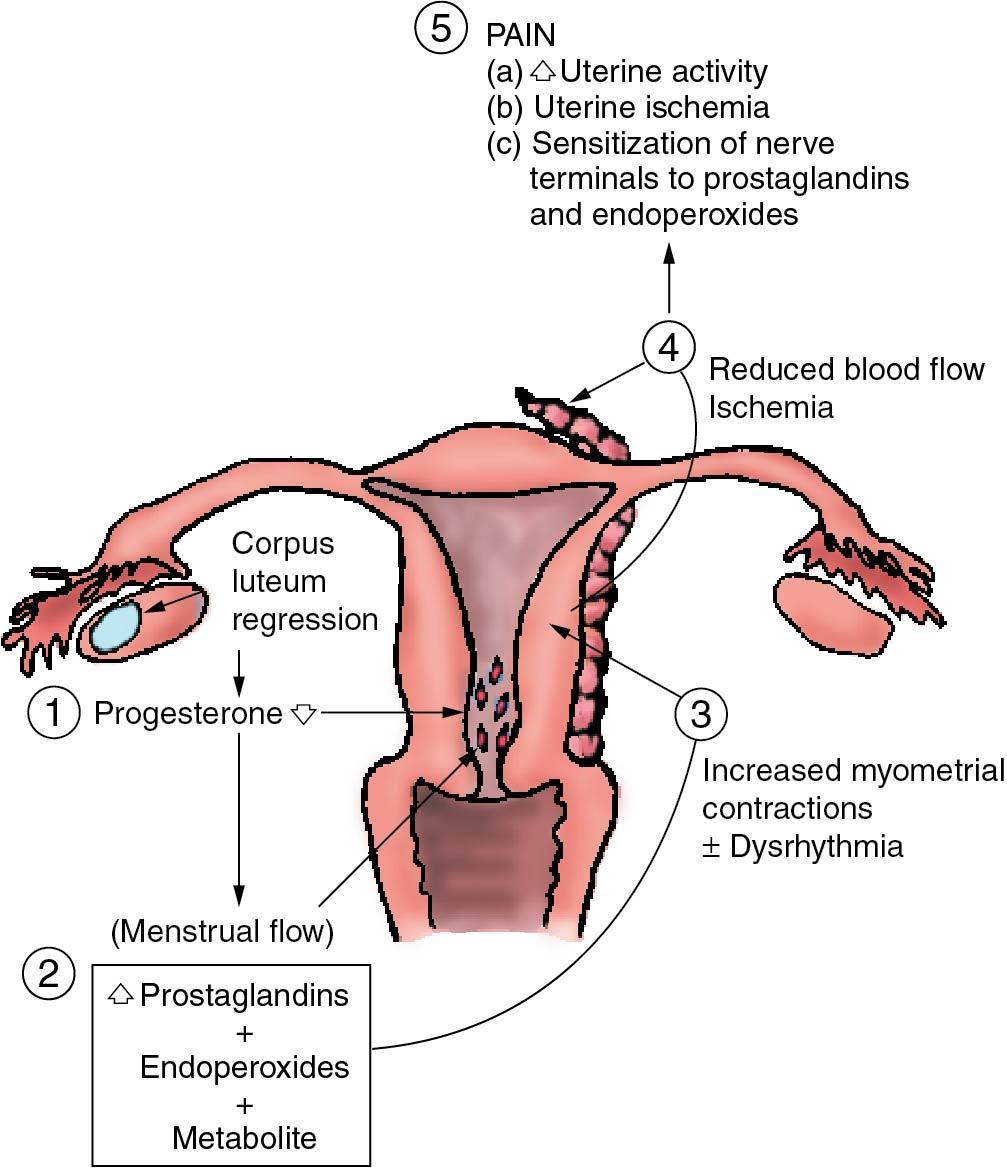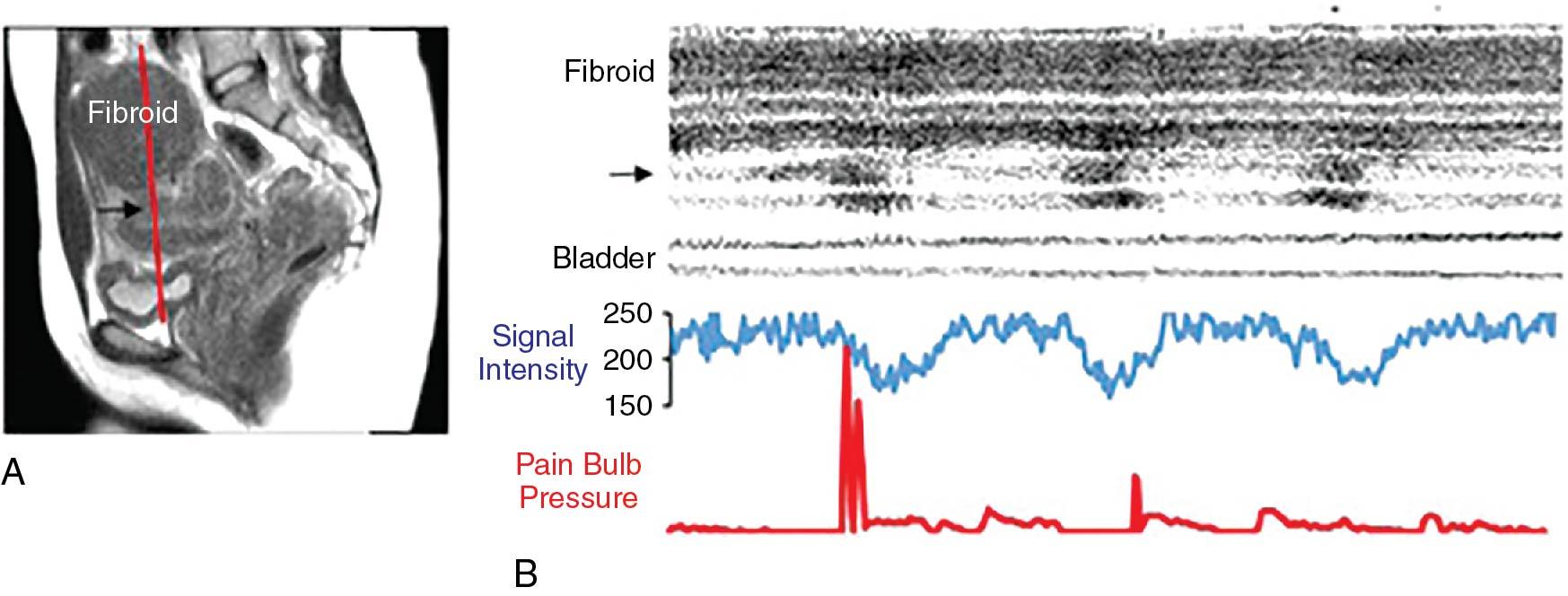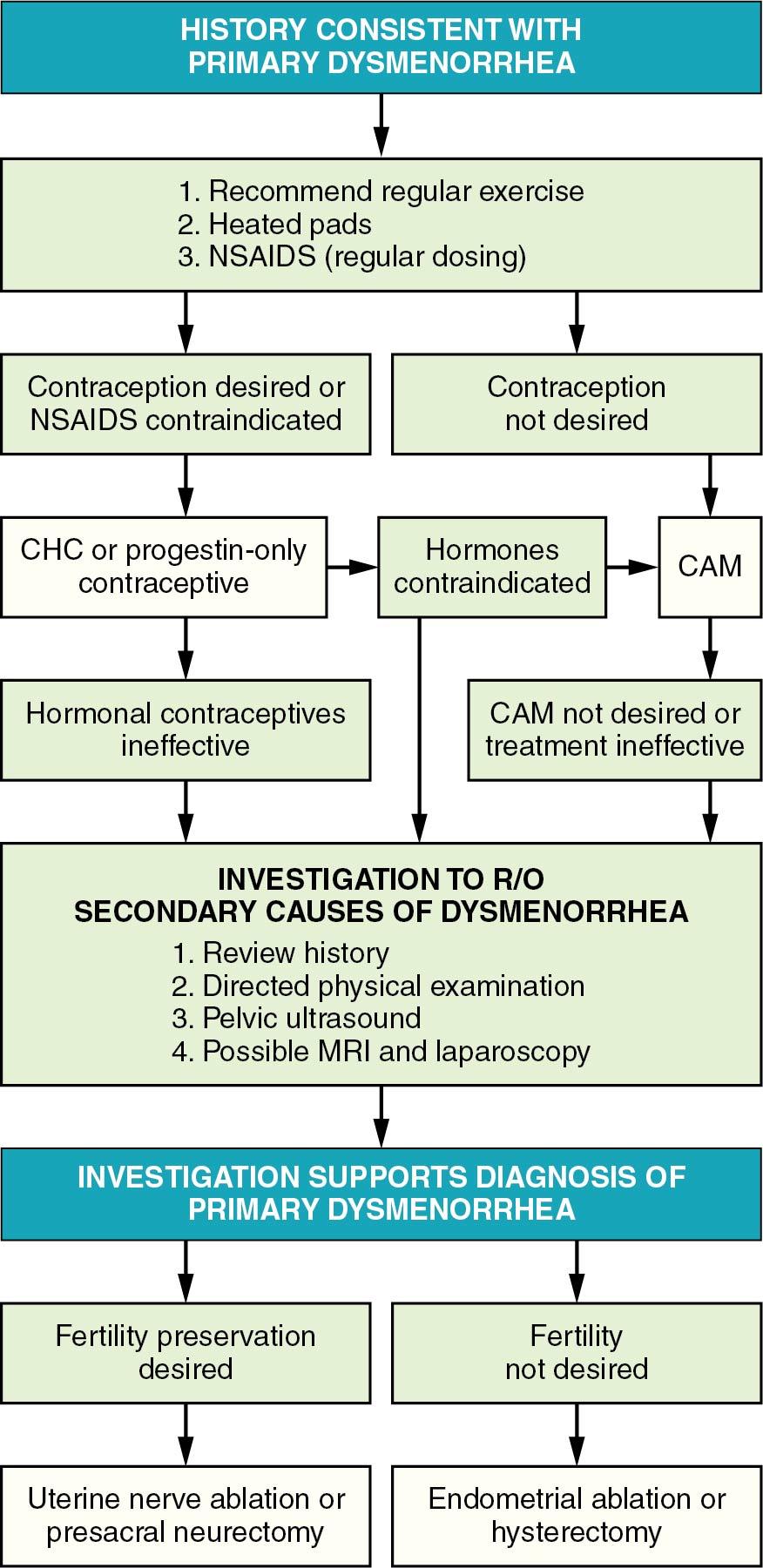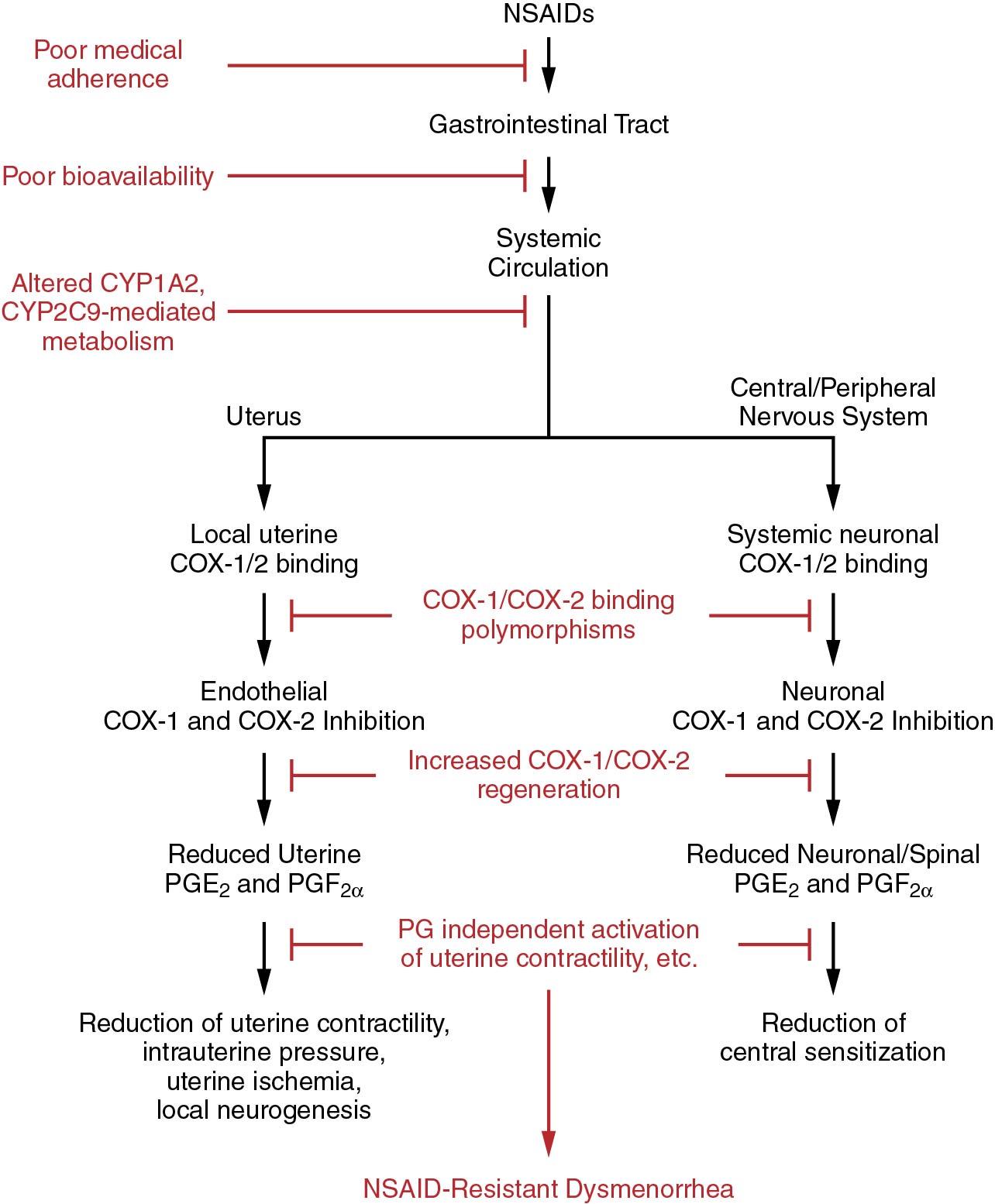Physical Address
304 North Cardinal St.
Dorchester Center, MA 02124
Approximately 75% of all women complain of primary dysmenorrhea. Approximately 15% have severe symptoms.
Education, supportive therapy, and nonsteroidal antiinflammatory drugs are the treatments of choice for primary dysmenorrhea. Combined oral contraceptives (COCs) reduce the prevalence and severity of dysmenorrhea. They can be used in extended cycles for better relief. This is also a reasonable first-line treatment, especially if contraception is desired.
Secondary dysmenorrhea can be due to a variety of both gynecologic and nongynecologic causes. Extensive history with directed physical and imaging are key to determining the specific diagnosis.
Approximately 3% to 8% of all women suffer from clinically relevant premenstrual syndrome (PMS), with 2% demonstrating premenstrual dysphoric disorder (PMDD). The most useful diagnostic tool in evaluating women with potential PMS or PMDD is a prospective symptom diary.
Therapy with psychoactive drugs, particularly selective serotonin reuptake inhibitors (SSRIs), has been demonstrated in randomized controlled trials to relieve PMS and PMDD symptoms. These medications should be considered first-line therapy. Specific cautions for the use of these agents must be followed. For women who also desire contraception, COCs are a valid option that have produced demonstrated improvement in PMS/PMDD symptoms.
Dysmenorrhea, premenstrual syndrome, and premenstrual dysphoric disorder afflict a large percentage of women in their reproductive years. These conditions have a negative effect on the quality of these women’s lives and the lives of their families, and they are also responsible for a huge economic loss as a result of the cost of medications, medical care, and decreased productivity. This chapter discusses current thinking with respect to the causes, pathophysiology, and management of these three conditions.
Dysmenorrhea is defined as a cyclic, painful cramping sensation in the lower abdomen often accompanied by other biologic symptoms, including sweating, tachycardia, headaches, nausea, vomiting, diarrhea, and tremulousness, all occurring just before or during the menses. Primary dysmenorrhea refers to pain with no obvious pathologic pelvic disease . It is currently recognized that these patients are suffering from the effects of endogenous prostaglandins. Secondary dysmenorrhea, on the other hand, is due to pelvic pathologic conditions ( ). Primary dysmenorrhea almost always first occurs in women younger than 20. Indeed, the woman will report pain as soon as she establishes ovulatory cycles. Secondary dysmenorrhea may occur in adolescents and in women of any age.
Several studies have attempted to determine the prevalence of dysmenorrhea; a wide range (16% to 90%) has been reported. These studies have been performed on students, teenagers, and their mothers, as well as individuals from various specific populations, such as industrial workers or college students. The best estimate of the prevalence of primary dysmenorrhea is approximately 75%. surveyed all the 19-year-old women in the city of Gothenburg, Sweden. A total of 90.9% of these women responded to a randomly distributed questionnaire, and 72.4% of these stated that they suffered from dysmenorrhea. In addition, 34.3% of the total population reported mild menstrual symptoms, 22.7% cited moderate symptoms that required analgesia, and 15.4% stated that they had severe dysmenorrhea that clearly inhibited their working ability and that could not be adequately assuaged by general analgesia ( ) ( Table 35.1 ). A 2005 Canadian study of 1546 menstruating women reported that 60% had primary dysmenorrhea and 60% of those affected reported their pain as moderate or severe ( ). Similarly, 17% missed school or work. Most women do not have any specific risk factors for this disorder; however, factors that may reduce the risk of developing dysmenorrhea include the following:
Younger age at first childbirth
Higher parity
Physical exercise
Oral contraceptive pill use
| Severity | Number of Women | Percentage of Total |
|---|---|---|
| None | 162 | 27.6 |
| Mild † | 201 | 34.3 |
| Moderate ‡ | 133 | 22.7 |
| Severe § | 90 | 15.4 |
* In a population of 586 19-year-old Swedish women.
† No systemic symptoms, medication rarely required, work rarely affected.
‡ Few systemic symptoms, medication required, work moderately affected.
§ Multiple symptoms, poor medication response, work inhibited.
Risk factors that have been reported to increase the risk of dysmenorrhea include ( ) the following:
Age younger than 30
Body mass index less than 20 kg/m 2
Prolonged duration of menses
Irregular or heavy menses
Premenstrual syndrome
Pelvic inflammatory disease
Sterilization
History of sexual assault
Heavy smoking
Family history (particularly if mother or sister has dysmenorrhea as well)
have demonstrated a significant positive correlation among the severity of dysmenorrhea and duration of menstrual flow, amount of menstrual flow, and early menarche. They showed no relationship with the actual duration of the menstrual cycle. In their series, 38.3% of patients reported that they had experienced dysmenorrhea for the first time during the first year after menarche, and only 20.8% reported that dysmenorrhea had not occurred until 4 years after menarche.
The pathogenesis of dysmenorrhea is that of elevated prostaglandin F2 alpha (PGF2 α) and E2 (PGE2) levels in the secretory endometrium resulting in uterine hypercontractility, thus leading to the symptoms of severe cramping. When menses begins, the simultaneous decreases in circulating progesterone and estradiol lead to increased transcription of endometrial collagenases, matrix metalloproteinases (MMPs), and inflammatory cytokines. Upregulated MMPs target and break down endometrial tissue, freeing phospholipids from the cellular membrane. Phospholipases convert uterine phospholipids to arachidonic acid. Arachidonic acid, the precursor to prostaglandin production, has been found in increased amounts in the endometrium during ovulatory cycles. Arachidonic acid is converted to PGF2α, PGE2, and leukotrienes, which are involved in increasing myometrial contractions.
During menses, these contractions decrease uterine blood flow and cause ischemia and sensitization of pain fibers ( Fig. 35.1 ). Endometrial concentrations of PGF2α and PGE2 correlate with the severity of dysmenorrhea; cyclooxygenase inhibitors decrease menstrual fluid prostaglandin levels and decrease pain. In a small 2018 study, magnetic resonance imaging (MRI) correlated uterine cramping with myometrial changes of both uterine pressure and hemodynamic dysfunction with decreased blood flow ( Fig. 35.2 ). PGF2α and PGE2 affect other organs such as the bowel and result in nausea, vomiting, and diarrhea.


The diagnosis of primary dysmenorrhea is made largely by history and physical examination. Patients typically complain of midline, crampy, lower abdominal or suprapubic pain, which begins with the onset of menstruation. The pain gradually resolves over 12 to 72 hours. Pain does not occur at times other than menses and only occurs in ovulatory cycles. Diarrhea, headache, fatigue, and malaise may be reported. Women with primary dysmenorrhea have a normal pelvic examination. Pelvic ultrasound should be considered in the evaluation of dysmenorrhea to evaluate for secondary causes. There are no laboratory or imaging abnormalities associated with primary dysmenorrhea.
Canadian 2017 consensus guidelines include a dysmenorrhea history checklist:
Menstrual history
Relationship between menarche and onset of dysmenorrhea
Timing of pain in relation to menses and amount of menstrual flow
Characterization, severity, chronology, and resulting disability
Sexual history, including inquiry about sexual abuse
Inquiry about chronic pain syndromes and medical conditions
Presence of symptoms of depression, anxiety, or other psychiatric disorders
Previous treatment, including dose, duration of use, side effects, and response
They also include a primary dysmenorrhea treatment algorithm ( Fig. 35.3 ).

Treatment for primary dysmenorrhea begins with providing patient education and reassurance. Individualized, supportive therapy can then be tailored to the patient’s specific symptoms, degree of disability from those symptoms, and other health care considerations, such as need for contraception ( ).
Cochrane conducted a systematic review of the literature in 2010. Only one randomized controlled trial (RCT) was included that demonstrated efficacy of aerobic exercise in reducing dysmenorrhea. In 2018, a more contemporary systematic review concluded that physical activity may be effective for mitigating primary dysmenorrhea. Although the included studies were of low to moderate quality ( ), the many other benefits from exercise warrant its recommendation as first-line therapy for women suffering from significant dysmenorrhea.
Two RCTs have shown that heat applied to the low abdomen, in the form of a patch or wrap, was effective in reducing dysmenorrhea. Unlike medications, this intervention has no side effects.
In 2007, a Cochrane review revealed some evidence from five RCTs that a variety of behavioral interventions may help reduce cyclic menstrual pain; however, the authors cautioned that the data were of limited quality, with small sample sizes, and the included studies suffered from some methodologic limitations. Interventions that have been used and studied include relaxation training, biofeedback, Lamaze exercises, hypnotherapy, imagery, coping strategies, and desensitization procedures ( ).
Dietary and vitamin therapies may be beneficial but to date have not been studied in a rigorous fashion. A low-fat vegetarian diet decreased menstrual pain in one study, and vitamin E was more effective than placebo in reducing dysmenorrhea in adolescents. Vitamins B 1 and B 6 , fish oil supplements, fish oil plus B 1 , ginger (750 to 2000 mg), valerian, zinc, and a Japanese herbal combination have been helpful in reducing pain compared with placebo in small trials.
Nonsteroidal antiinflammatory drugs (NSAIDs) are first-line therapies for primary dysmenorrhea . NSAIDs are prostaglandin synthetase inhibitors (PGSIs). They are divided into two chemical groups: the arylcarboxylic acids, which include acetylsalicylic acid (aspirin) and fenamates (mefenamic acid); and the arylalkanoic acids, including the arylpropionic acids (ibuprofen, naproxen, and ketoprofen) and the indoleacetic acids (indomethacin). The more specific cyclooxygenase (COX-2) inhibitors such as celecoxib have similarly been shown to alleviate the primary dysmenorrheal symptoms. COX-2 expression in the uterine glandular epithelium was maximal during menstruation in one trial of ovulatory women, suggesting a possible association with the cause. The increased expression of COX-2 was eliminated with continuous use of oral contraceptives (OCs), which also offer an effective treatment (discussed later). The specific effect of these agents on the uterine musculature is reduction of contractility, as measured by reduction of intrauterine pressure. COX-2 inhibitors may be considered for women with gastrointestinal toxicity caused by NSAIDs; however, these agents carry a risk of serious adverse events and now contain a black box warning. These medications therefore should only be used with caution and full disclosure.
In 2015, Marjoribanks provided a review to the Cochrane Database of RCTs of NSAIDs in the treatment of dysmenorrhea. Eighty RCTs were included, including 20 different NSAIDs (both nonselective and COX-2–specific formulations). NSAIDs were substantially more effective than placebo in pain reduction (odds ratio [OR], 4.37; 95% confidence interval [CI], 3.76 to 5.09). There was no significant difference if efficacy among the variety of NSAIDs. Side effects involving the gastrointestinal track and neurologic systems occurred in 11% to 14% of women taking NSAIDs and should be considered when prescribing these medications ( ).
NSAIDs should be given the day before the expected menses or at the onset of menses. If one NSAID is ineffective, switching to a different class of NSAIDs may be helpful. NSAIDs should not be given to patients who have shown previous hypersensitivity to such drugs. They are also contraindicated for women who have had nasal polyps, angioedema, and bronchospasm related to aspirin or NSAIDs. In addition, these agents are contraindicated for individuals with a history of chronic ulceration or inflammatory reaction of the upper or lower gastrointestinal (GI) tract and for those with preexisting chronic renal disease. During the use of these agents, autoimmune hemolytic anemia, rash, edema and fluid retention, and central nervous system (CNS) symptoms, such as dizziness, headache, nervousness, and blurred vision, can occur. In up to 15% of users, a slight elevation of hepatic enzyme levels may also be found. Table 35.2 lists some NSAIDs commonly used for the treatment of dysmenorrhea.
| Class | Brand Name | Generic Name | Usual Regimen (mg) * | Initial Dose | Subsequent Dose |
|---|---|---|---|---|---|
| Propionic acid | Motrin | Ibuprofen | 400 (qid)–800 (tid) | 500 | 250 tid-qid |
| Naprosyn | Naproxen | 250 (qid)–500 (bid) | |||
| Anaprox | Naproxen sodium | 275 (qid)–550 (bid) | |||
| N/A | Ketoprofen | 25-75 (tid) | |||
| Nalfon | Fenoprofen calcium | 200 (qid) | |||
| Fenamic acid | Ponstel | Mefenamic acid | 250 (qid) | 550 | 275 tid-qid |
| N/A | Meclofenamate | 100 (qid) | |||
| Acetic acid | Indocin | Indomethacin | 25 (tid) | 50 | 25-50 tid-qid |
| Voltaren | Diclofenac | 75 (bid) | |||
| N/A | Tolmetin | 400 (tid) | |||
| N/A | Diflunisal | 500 (bid) | |||
| N/A | Etodolac | 400 (tid-qid) | |||
| Toradol | Ketoralac | 10 (qid) | |||
| Oxicams | Feldene | Piroxicam | 20 (qd) | 500 | 250 qid |
Roughly 18% of women have dysmenorrhea that is resistant to NSAIDs. Fig. 35.4 summarizes potential mechanisms that may be responsible lack of NSAID response.

Combined contraceptives (CCs) containing estrogen and progesterone will relieve the symptoms of primary dysmenorrhea in approximately 90% of patients. CCs suppress ovulation and endometrial proliferation, and the progestin component also blocks the production of the precursor to prostaglandin formation. The thinned endometrium from CCs then contains less arachidonic acid, which is the precursor to prostaglandins. As a result of these mechanisms, there is less uterine contractility and resultant pain with menses. If the woman also requires contraception, CC therapy may prove to be the treatment of choice.
In 2009, Wong and colleagues provided a review to the Cochrane Database of RCTs comparing combined oral contraceptives (COCs) with differing dosages of COCs, placebo, and NSAIDs. Six studies revealed that COCs were significantly more effective than placebo for the treatment of dysmenorrhea (OR, 2.99; 95% CI, 1.76 to 5.07) ( ).
In small RCTs, low-dose oral contraceptives (OCs with 20 µg ethinyl estradiol) were effective in reducing dysmenorrhea in adolescents and adult women. Continuous OC administration compared with traditional monthly cyclic dosing in systematic review seems to be more effective at reducing dysmenorrhea. Breakthrough bleeding can be an undesirable side effect, although a review of RCTs reported bleeding and discontinuation rates to be similar. The extended-cycle OCs available are also associated with less dysmenorrhea than are monthly cyclic OCs.
The vaginal ring CC has also been shown to reduce dysmenorrhea in a similar fashion as COCs. Dysmenorrhea was not, however, as well controlled in women using the transdermal CC patch compared with COCs ( ).
Depot medroxyprogesterone (DMPA), a long-acting injectable contraceptive, has not been studied specifically for primary dysmenorrhea. Trials in contraceptive studies report a reduction in dysmenorrhea in adolescents. Systemic progestins result in thinned endometrium and can lead to infrequent menses or amenorrhea. After 1 year of DMPA use, approximately 50% of women experience amenorrhea and resultant cessation of dysmenorrhea.
The 20 μ g levonorgestrel-releasing intrauterine system (LNG-IUS) has been shown in RCTs to reduce menstrual pain. Levonorgestrel is a 19-nortestosterone derivative affecting endometrial progesterone receptors, leading to an atrophic endometrial lining. In 2013 a smaller LNG-IUS containing only 14 μ g of levonorgestrel was approved by the U.S. Food and Drug Administration (FDA) and may represent another option for the management of dysmenorrhea ( ). Of note, by comparison, the copper T380A intrauterine device (IUD) often increases dysmenorrhea.
The single-rod etonogestrel-releasing contraceptive (current version, Nexplanon) has also been shown in clinical trials to reduce dysmenorrhea. This long-acting reversible contraceptive also offers excellent contraption for those women who need it.
Because of their ability to block uterine contractility, tocolytics may be beneficial in the treatment of dysmenorrhea. Studies using nifedipine at a dose of 20 to 40 mg orally have demonstrated pain relief. Moderate pain relief was noted in 36 of 40 women, but side effects of facial flushing, tachycardia, and headache can occur. Glyceryl trinitrate and magnesium have also been studied in limited fashion and have demonstrated effectiveness in reducing cyclic menstrual pain. Ongoing large-scale research is needed to assess safety and efficacy; therefore these medications are not often used for contemporary management of dysmenorrhea.
Narcotic analgesics are often used in treating patients with general chronic pain syndromes; however, because of the very real potential for dependency or abuse, they should not be used in dysmenorrhea management.
A meta-analysis of three trials has reported that transcutaneous electrical nerve stimulation (TENS) is more effective than placebo in relieving dysmenorrhea, although it is not as effective as analgesics. Milsom and colleagues in Sweden and Smith and Heltzel in the United States have noted that TENS relieves menstrual pain without reducing intrauterine pressure, suggesting that its mode of action may be in the CNS. High-frequency TENS provides more dysmenorrheal pain relief compared with placebo or low-frequency TENS ( ; ).
Acupuncture and acupressure have been used for the management of dysmenorrhea. Several studies have evaluated the effectiveness of these complementary alternatives; however, they were of low quality. A 2018 randomized study used a smartphone application for self-acupressure in 221 women. Modest differences were notes with some reduction in mean pain scores. There is limited evidence that acupuncture may be of benefit.
A 2005 meta-analysis of eight RCTs of surgical interruption of nerve pathways concluded that there was insufficient evidence to advise laparoscopic uterine nerve ablation (LUNA) or laparoscopic presacral neurectomy (LPSN) for primary dysmenorrhea ( ).
Become a Clinical Tree membership for Full access and enjoy Unlimited articles
If you are a member. Log in here